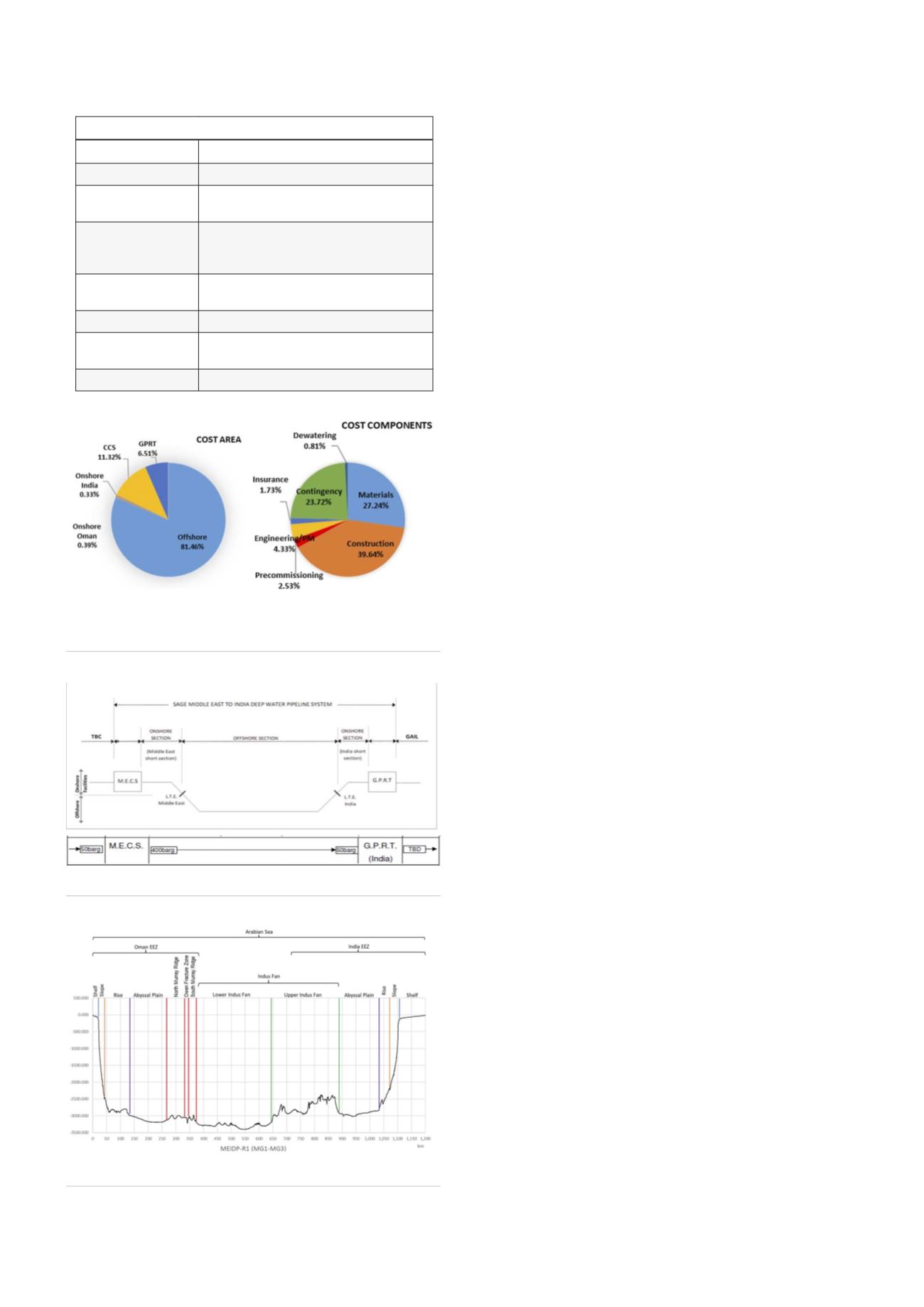
Project economics
SAGE has prepared detailed cost estimates for the onshore
facilities and offshore pipeline. The estimated project cost
is approximately US$4.5 billion, based on the cost update
performed in 2017. The breakdown of the expenditure in terms
of cost area and cost components is provided in Figure 1.
Project history
Over the last three decades, two offshore gas supply projects
have considered the deepwater route across the Arabian Sea to
the Gujarat coast of India. The first was proposed by the Oman
to India pipeline (OIP) project in the mid 1990s, bringing gas
from the Arabian Sea coast of Oman. The second was proposed
in 2003 by the India state gas company GAIL and the Iranian
National Oil Company (NIOC) in a joint venture, bringing gas
from the Arabian Sea coast of Iran. The OIP project highlighted
several technical challenges:
)
Pipe mill capability to manufacture very thick wall linepipe.
)
Pipelay vessel tension capability for installing pipelines in
3500 m water depth.
)
Availability of deepwater pipeline repair systems.
)
Understanding of geohazard issues and potential mitigation.
)
Concerns about flooding, hydrotesting, and drying the
pipeline.
The technical issues were not considered to be hindrances,
however, the OIP project did not go ahead because Omani
sourced gas was reassigned to the Qalhat LNG project.
Encouraged by developments in pipe mill capabilities and
installation vessel improvements, in 2006 SAGE decide to
restart the idea of a gas pipeline joining Oman to India, and
commissioned the first engineering studies to look at initial
feasibility of a pipeline from the Middle East. In 2010, SAGE
employed Peritus International as the project management
consultants for the project. Between 2010 and 2013, numerous
formal feasibility and definition studies and cost estimates
were undertaken for the offshore pipeline and onshore
facilities studies. Technical viability was confirmed by Peritus
International in 2013.
Due to the positive results of these feasibility studies,
SAGE decided to move the project forward by undertaking a
reconnaissance marine survey (RMS).
Studies since 2016 have concentrated on updating previous
work, agreeing the qualification plan to be taken forward
into FEED, and continuing with a pipe mill pre-qualification
programme for non-Indian pipe mills:
•
Flow assurance update – Peritus International (2016).
•
Mechanical design update – Peritus International (2016).
•
Updated cost estimate and schedule – Peritus
International (2016).
•
Chinese pipe mill qualification – PCK (2016).
•
Technical review workshop – SAGE/Peritus/IntecSEA/
EIL/DNVGL/Saipem/Allseas (2016).
•
Technical feasibility confirmation – DNVGL (2017).
Figure 1.
MEIDP cost components and cost areas (2017 cost
update).
Figure 2.
MEIDP battery limits.
Figure 3.
MEIDP base case route profile.
Table 1.
Identified risks along the pipeline route
Geohazard
Location
Tsunami
Oman and Indian coastline
Steep slopes
Oman and Indian continental slopes and the
Qalhat Seamount
Seismic activity
Northern Oman, Kathiawar Peninsula
(Gujarat, India) and along the Owen Fracture
Zone
Fault displacements Faults of the Owen Fracture Zone and the
Indian shelf and slope
Liquefaction
Oman and Indian (inner) shelf
Slope failures
Oman and Indian continental slope, Qualhat
Seamount, channels of the Indus Fan
Turbidity currents
Indus Fan
24
World Pipelines
/
MARCH 2020








